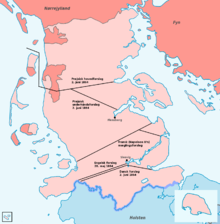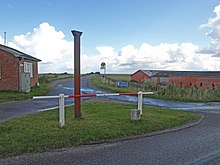Border between Denmark and Germany




The border between Denmark and Germany is 67 kilometers long (land border only, as the sea border has not been finally determined).
history
In the year 811 the Danish King Hemming and Charlemagne established the Eider (Danish Ejderen ) as the border between the Danish and Frankish empires . A few kilometers north of the Eider - between Windebyer Noor and Treene - the Danewerk functioned as a Danish border wall. After the duchies of Schleswig had been established as a Danish and Holstein as a Roman-German fiefdom, the Eider remained the border river between the two territories. The border between Holstein and the rest of Germany was marked by the Elbe , while the border between Schleswig ( Sønderjylland ) and the rest of Denmark ( Nørrejylland ) was marked by Königsau (Danish Kongeåen ). After the German-Danish War of 1864, in the Peace Treaty of Vienna concluded between Prussia, Austria and Denmark, the duchies of Schleswig , Holstein and Lauenburg were dissolved from Danish sovereignty and placed under joint administration by Prussia and Austria .
With the incorporation of Schleswig into the Prussian sphere of influence, the new Prussian-Danish border at Königsau was established.
In paragraph 5 of the Prague Peace Treaty of 1866 after the German War , Prussia committed itself to French pressure against England and France to hold a referendum on citizenship within 6 years in the northern part of Schleswig, which was ceded to Prussia after the German-Danish War of 1864 . Denmark was officially notified of this provision. Bismarck let the six years pass and did not comply with this provision, even after Danish warnings to fulfill the contract. In 1878, at the instigation of Bismarck, this North Schleswig clause of the Peace of Prague was repealed in a secret agreement between Germany and Austria before the start of the Berlin Congress . This agreement was not published until six months later, because Austria wanted to avoid making it look as if Germany had done something before the Berlin Congress. Therefore, this agreement was only announced in the Reichsanzeiger on February 4, 1879 . Despite this, Denmark continued to keep the German promise to hold a referendum in North Schleswig. Only in 1907 recognized Denmark in Optantenvertrag Copenhagen the demarcation of 1864 as final.
After the defeat of the German Empire in World War I , in which Denmark did not take part, the Versailles Treaty provided for a referendum for the northern areas of Schleswig, defining the voting zones and modalities according to Denmark's wishes. Since the referendum in Schleswig in 1920, the German-Danish state border has run north of Flensburg (→ Clausen line ).
If the Morgenthau plan of 1944 had been implemented, the border would have run north of the planned international zone around the Kiel Canal. The British September Note of 1946 also included the possibility of a border revision.
With Denmark's accession to the Schengen Agreement , border controls ceased to exist on March 25, 2001 and the free movement of people was introduced. However, a passport or a passport substitute (identity card) must still be carried.
On March 14, 2020, Denmark closed all of its borders due to the COVID-19 pandemic . The Prime Minister Mette Frederiksen had announced this the evening before. Commuters, Danish citizens and people with legitimate reasons are still allowed to cross the border. Two days later, Germany also closed the border with Denmark accordingly.
Wild boar fence
The Danish Nature Management Agency ( Naturstyrelse ) of the Ministry of Environment and Food started erecting a wild boar fence along the border near Padborg on January 28, 2019 . The one and a half meter high fence is intended to prevent wild boars from crossing the border and is part of the agreement between the minority government of Prime Minister Lars Løkke Rasmussen and the Dansk Folkeparti from March 2018 on the increased use against African swine fever (ASP). 20 border crossings are to remain open for traffic and there are to be passages on hiking trails for pedestrians and cyclists.
The fence was completed in early December 2019. It is around 70 kilometers long, on average 1.50 m high and cost between six and eight million euros. However, experts point out that swine fever is mainly spread through humans, for example through mud in the wheel arches of vehicles, shoe soles or food thrown away with the meat of infected animals. Conservationists also criticize that the fence also cuts up the habitats of other wild animals.
The eastern end of the Flensburg Fjord (Danish: Flensborg Fjord )
Border crossing at Rønsdam with wild boar fence , cattle barriers and a barrier erected under the corona pandemic
Passage of the Gendarmstien hiking trail near Padborg
Municipalities on the state border (from west to east)
|
GERMANY |
DENMARK |
||||||
|---|---|---|---|---|---|---|---|
| state | circle | local community | Border crossing |
Border crossing |
Commune | region | |
 Schleswig-Holstein |
North Friesland |
|
N o r d s e e |
|
|
Syddanmark | |
|
|
|||||||
|
|
|||||||
|
|
|||||||
|
|
|
||||||
|
|
|||||||
|
|
|||||||
|
|
|||||||
|
|
|
||||||
|
|
|
||||||
|
|
|||||||
|
|
|||||||
|
Schleswig-Flensburg |
|
||||||
|
|
|||||||
|
|
|||||||
|
|
|||||||
|
|
|||||||
|
|
|
||||||
| O s t s e e |
|||||||
|
|
|||||||
|
Schleswig-Flensburg |
|
||||||
|
|
|||||||
|
|
|||||||
|
|
|||||||
|
|
|||||||
|
|
|||||||
|
|
|||||||
|
|
|||||||
|
|
|||||||
|
|
|||||||
literature
- Daniel-Erasmus Khan : The German State Borders: Legal-Historical Basics and Open Legal Issues Chap. VI: The German-Danish border, pp. 347–398. Mohr Siebeck , 2004, ISBN 9783161484032 .
Web links
- 100 years of demarcation. In: shz.de . Schleswig-Holsteinischer Zeitungsverlag , 2020, accessed on February 3, 2020 .
Individual evidence
- ↑ destatis.de
- ^ Robert Bohn: History of Schleswig-Holstein . CH Beck, 2006, ISBN 978-3-406-50891-2 , pp. 9 .
- ↑ What happened in 1864 ( Memento of May 10, 2010 in the Internet Archive ) Dybbøl Banke History Center
- ^ Troels Fink: Germany as a problem of Denmark - the historical prerequisites of Danish foreign policy . Christian Wolff, Flensburg 1968, p. 70 f.
- ↑ Dieter Gosewinkel: Naturalization and exclude. The nationalization of citizenship from the German Confederation to the Federal Republic of Germany (= critical studies on historical science . Volume 150). Vandenhoeck & Ruprecht , Göttingen 2001, ISBN 3-525-35165-8 , p. 208.
- ↑ Kurt Keppler: Death over Germany - The Morgenthauplan . In: Publications of the Institute for German Post-War History . Grabert-Verlag, Tübingen 1971, ISBN 3-87847-023-1 , p. 260 f .
- ↑ NDR: Coronavirus: Denmark has closed the border. Retrieved March 16, 2020 .
- ↑ Police Denmark: Tyskland lukker gränsen til Danmark. Retrieved May 21, 2020 (Danish).
- ↑ South and South Jutland Politi: Tyskland has a permanent hatch for tourism and green trade. Retrieved May 21, 2020 (Danish).
- ↑ Fear of swine fever: Denmark isolates itself. In: Deutsche Welle . January 28, 2019, accessed January 28, 2019 .
- ↑ Anti-wild boar fence “They're crazy, the Danes”. In: Welt.de . January 28, 2019, accessed January 29, 2019 .
- ↑ Peer-Axel Kroeske, Susanne Betz: Swine fever: Denmark's borderline fence. In: Bayerischer Rundfunk. December 15, 2019, accessed December 25, 2019 .
- ↑ Denmark completes wild pig fence. ndr.de, December 2, 2019.








